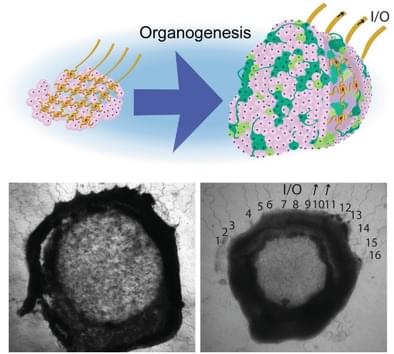Researchers have developed a way to identify sources of error in quantum computers through Artificial intelligence and machine learning. Now they can reduce quantum computing errors using custom machine learning algorithms.


Researchers have developed a way to identify sources of error in quantum computers through Artificial intelligence and machine learning. Now they can reduce quantum computing errors using custom machine learning algorithms.

There is a cyborg organoid platform developed by integrating “tissue-like” stretchable mesh nanoelectronics with 2D stem cell sheets. Leveraging the 2D-to-3D reconfiguration during organoid development, 2D stem cell sheets fold and embed stretchable mesh nanoelectronics with electrodes throughout the entire 3D organoid. The embedded electronics can then enable continuous electrical recording.
Scientists design stretchable mesh nanoelectronics, mimicking the mechanical and structural properties of brain organoids to build cyborg human brain organoids.
Using the 3D embedded stretchable electrodes, achieved reliable long-term electrical recording of the same hiPSC-derived neural tissue at single-cell, millisecond spatiotemporal resolution for 6 months, revealing the evolution of the tissue-wide single-cell electrophysiology over hiPSC-derived neuron development. Applying this technology to brain organoids at early developmental stages, they traced the gradually emerging single-cell action potentials and network activities.
#biomimicry #meshelectronics #hiPSC #neurallace #neuroscience
Building cyborg brain organoids through the integration of stretchable mesh nanoelectronics with human induced pluripotent stem cell derived progenitors and neurons through organogenesis is reported…
SpaceX is gearing up to launch the Starship into orbit, the biggest test yet for the ship designed to send humans to Mars and beyond.

There are around 110,000 public charging points in the US and a new study says they will soon surpass the number of gas pumps.

U.S. startup Geoship have created ‘dome homes’ which last up to 500 years and are resistant to fire, floods, earthquakes and hurricanes.
Made of earth-friendly bioceramic, Geoship’s geodesic domes envision a new future for humanity.
Although no images of the built domes have been released yet, Geoship has shared these renders of what the dwellings could look like.
Billionaire entrepreneur and shark tank star Mark Cuban says he’s heavily invested in two popular altcoins while waiting for the first viral crypto app to emerge.
In a new interview with Crypto Banter, Cuban says that he owns “a lot” of Ethereum (ETH) and Polygon (MATIC) due to their strong use cases.

Two recent collaborations between mathematicians and DeepMind demonstrate the potential of machine learning to help researchers generate new mathematical conjectures.